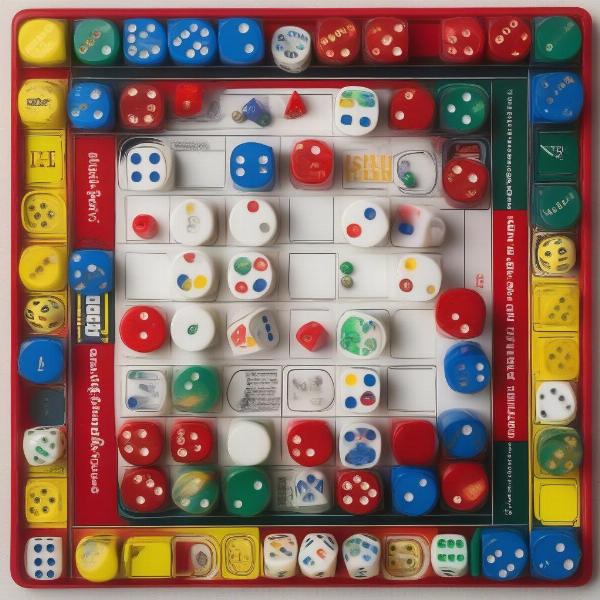Are you ready to learn the can’t stop board game rules and jump into a game of thrilling risk and reward? This classic dice game is simple to learn but offers strategic depth that will keep you coming back for more. At SupremeDuelist.blog, we believe understanding the rules of a game is the first step to mastering it, and we’re here to guide you through every step of the way. With clear explanations and helpful tips, you’ll be rolling the dice and racing up the board in no time.
Our mission at SupremeDuelist.blog is to provide gamers of all levels with the most comprehensive and accessible guides to their favorite games, just like this one. We delve deep into the mechanics, tactics, and strategies that make each game unique, because we think understanding the nuances of play is what separates a casual player from a true master. So, whether you’re a seasoned board game enthusiast or a curious newcomer, you’ve come to the right place to grasp the can’t stop board game rules. Let’s dive in!
Setting Up Your Can’t Stop Game
Before you can start rolling dice and claiming columns, you’ll need to set up the game properly. Here’s what you’ll need to do:
- The Board: Place the game board in the center of the playing area. This board has columns numbered 2 through 12, each with a different number of spaces to reach the top.
- The Markers: Each player chooses a set of three colored markers. These markers will track their progress on the board.
- The Dice: Grab the four standard six-sided dice. These will be your engines for the game.
That’s it! Once you have these pieces in place, you are all set and ready to familiarize yourself with the can’t stop game rules.
 can’t stop game board setup and markers
can’t stop game board setup and markers
Understanding The Core Gameplay
The heart of Can’t Stop lies in its dice rolls and the strategic choices you make with them. Here’s a breakdown of how a player’s turn works:
- Rolling the Dice: At the start of your turn, roll all four dice.
- Forming Pairs: Divide the four dice into two pairs. For example, if you roll 1, 2, 3, and 4, you could pair them as 1+2 and 3+4.
- Choosing Your Move: Select one or two of those pairs to advance your markers on the board. If you chose to move on 3 and 7, place a marker on the corresponding column, if one doesn’t exist, or move your marker one space up the column if it is.
- Continuing Your Turn: If you’ve placed markers on one or two columns and want to try to move them further, roll the four dice again and repeat the process. The decision to continue after successfully moving one or two markers is optional.
- Busting: If you are unable to move markers on the board based on your dice rolls during a turn, your turn is over, and the markers on the board are removed. All progress is lost.
- Stopping and Securing Columns: If you decide not to roll again, you can “stop” your turn by securing all temporary markers onto the track. This means those markers become permanent and cannot be lost by future unsuccessful turns.
- End of a Turn: Once you have decided to stop, it becomes the next player’s turn.
These are the core mechanics of the game. It’s all about risk assessment. How far are you willing to push your luck? To gain a better understanding of the game, let’s look at what happens when you try to secure a column.
 dice combinations for cant stop game
dice combinations for cant stop game
Securing a Column
In the Can’t Stop board game, one of your goals is to reach the top of three different columns. However, you can’t keep going up the same column for multiple turns. This is where strategic planning comes in. Here’s how it works:
- Reaching the Top: A player fully completes a column by moving their marker to the very top space of that column.
- Securing: When a column is completed, the player places a marker at the top, securing the column. Other players cannot advance on this column for the rest of the game.
- Winning the Game: The first player to secure three columns wins. This can be any three columns of their choosing.
It is crucial to understand how to secure columns to win the game. But before securing, your markers may be lost. Let’s delve into what happens when you can’t move, which is called busting.
The Dreaded Bust
One of the thrilling aspects of Can’t Stop is the risk involved. It’s entirely possible you will “bust.” When that happens, you forfeit your chance of progressing on your current turn. Here’s what constitutes a bust:
- No Valid Move: If, after rolling the dice, you cannot form pairs that correspond to any of the columns that are temporarily marked, your turn ends immediately.
- Markers Removed: Any progress markers you placed on the board during that turn are removed, and you gain no secured progress.
Busting can be a setback, but it is part of the game’s inherent challenge. Now, if you are curious to learn more about the specific rules and strategies, check out our detailed guide on can’t stop game rules. It offers a deeper dive into the game.
“The beauty of Can’t Stop lies in its simplicity, yet the strategic depth emerges from the calculated risks each player must take,” says Dr. Eleanor Vance, a board game analyst and expert in game mechanics. She highlights the balance between pushing your luck and securing your progress that makes the game compelling.
Strategic Tips for Can’t Stop
Understanding the rules is important, but knowing some strategic tips can greatly improve your gameplay. Here are some pointers:
- Spread your markers: Don’t focus on just one column at the start of the game. Try to spread your temporary markers across a few different columns in the first few turns, to give yourself more options when rolling the dice.
- Prioritize columns with fewer spaces: Columns 7 have the highest spaces and also the highest probability. Columns 2 and 12 only have 3 spaces each, and might be easier to get a quick secure on in the early game.
- Know when to stop: Don’t get too greedy. There are times to push your luck and times when it’s better to secure your progress and end your turn.
- Watch your opponent: Pay attention to the columns your opponents are working on. Sometimes blocking them can be more beneficial than making your own move.
These tips will not guarantee a win, but they certainly will help you make more informed decisions. In addition, it would be beneficial to understand that Can’t Stop has different types of columns.
Different Columns and Probabilities
Each column in Can’t Stop presents unique challenges based on the number of spaces and the probability of rolling the dice combination:
- Columns 7: This column has the most spaces and the highest probability of being rolled. You will often find this one is highly contested.
- Columns 6 and 8: Columns 6 and 8 have slightly fewer spaces than 7, and a slightly lower probability of being rolled.
- Columns 5 and 9: These have less spaces than 6 and 8 and also are a little less probable to appear in the dice rolls.
- Columns 4 and 10: These have even less spaces and a lower probability than 5 and 9, and are not commonly used by players.
- Columns 3 and 11: These columns have very few spaces, but are quite unlikely to appear.
- Columns 2 and 12: These have the fewest spaces, but the lowest probability of being rolled.
Understanding the probabilities and spaces of the columns is crucial for strategic gameplay. Remember, strategy is important, but so is an understanding of the basic can’t stop game rules.
 cant stop game board columns with different probabilities
cant stop game board columns with different probabilities
“The varying probabilities of each column add a layer of depth to Can’t Stop. Players must balance the risk of busting with the potential reward of advancing on more difficult columns,” explains Marcus Bellwether, a board game design theorist. He highlights the strategic choices in managing risk.
Frequently Asked Questions About Can’t Stop Rules
Let’s tackle some of the most frequently asked questions about the Can’t Stop rules:
What happens if all the markers on the board are temporarily on columns that I cannot roll a pair for?
If all the markers on the board are temporarily on columns that do not match your dice rolls, you have busted, and you lose your progress on that turn. This is a critical part of the risk you take in the game.
Can I move one marker on two different columns in the same turn?
Yes, you can. If your dice rolls allow you to move markers on two different columns, you may do so. However, both of the markers must correspond to one of the pairs that you rolled.
How do I win the game?
The first player to secure three different columns wins the game. This is achieved by reaching the top space on any three different columns and placing a permanent marker at the top.
Are there any rule variants or alternative rules?
While the basic rules remain consistent, some people like to house rule various elements. One common rule variation is to reduce the number of temporary markers a player has at the start of the game.
Is there a strategy for winning?
Yes, there are many strategies to employ in the Can’t Stop game. Try focusing on the different column types, and choose based on the probability of your dice rolls.
For an even deeper explanation of these and other rules, visit our page on can’t stop game rules. We have a plethora of information to help you master the game.
Conclusion
Understanding the Can’t Stop board game rules is your first step to enjoying this classic game of risk and reward. From the basic gameplay mechanics to advanced strategies, it’s a game that offers engaging experiences for everyone. Whether you are a casual player or a strategic mastermind, you will find yourself caught in the thrill of rolling the dice and making strategic decisions.
Here at SupremeDuelist.blog, we strive to empower gamers with the knowledge they need to excel in their favorite games. We hope this comprehensive guide has provided you with the insight needed to master Can’t Stop. So go ahead, roll the dice and remember to check back for more gaming tips and strategies at SupremeDuelist.blog. Are you ready to give it a try?
Leave a Reply